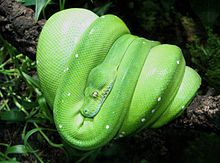Green tree python
| Morelia viridis | |
|---|---|
 |
|
| Scientific classification | |
| Kingdom: | Animalia |
| Phylum: | Chordata |
| Subphylum: | Vertebrata |
| Class: | Reptilia |
| Order: | Squamata |
| Suborder: | Serpentes |
| Family: | Pythonidae |
| Genus: | Morelia |
| Species: | M. viridis |
| Binomial name | |
|
Morelia viridis (Schlegel, 1872) |
|
| Synonyms | |
|
|
Morelia viridis, commonly known as the green tree python is a species of python found in New Guinea, islands in Indonesia, and Cape York Peninsula in Australia.
The green tree python is characterized by a relatively slim body. The relatively long tail accounts for about 14% of the total length. The head is large and clearly defined from the neck. The snout is large and angular. The body is triangular in cross section with a visible spine. The species usually reaches a total length of 150–180 cm (4.9–5.9 ft), but large females may reach 200 cm (6.6 ft). The size also varies depending on the region of origin. The weight is highly dependent upon the nutritional status of the animal. Males can weigh about 1,100–1,400 g (2.4–3.1 lb), females up to 1,600 g (3.5 lb), although wild specimens are typically much lighter than this. Especially large specimens that can weigh up to 2,200 g (4.9 lb) are invariably females, which like most snakes are slightly larger and heavier than males.
They are found in Indonesia (Misool, Salawati, Aru Islands, Schouten Islands, most of Western New Guinea), Papua New Guinea (including nearby islands from sea level to 1,800 m elevation, Normanby Island and the d'Entrecasteaux Islands) and Australia (Queensland along the east coast of the Cape York Peninsula). The type locality given is "Aroe-eilanden" (Aru Islands, Indonesia).
This species is sympatric with M. spilota and the two often compete in the same ecological niche.
...
Wikipedia

